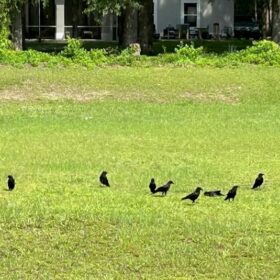I am always alert to the possibilities of new columns and sometimes my Facebook friends provide a good source for me. This week a retired University of Florida professor friend of mine, Steve Humphrey, posted this intriguing comment along with an illustrative photo.

“The picture is from a walk past a shallow water retention basin west of Gainesville, Florida, ~10 a.m. this morning. Seven crows were initially in a small circle and calling loudly around an eighth, dead crow, then dispersed and flew up into a tree where they continued to call.”
As the scientist that he is, Steve did not mention the words that immediately come to mind, “crow funeral.” It turns out that many others have noticed this same behavior when a crow finds a dead one of its kin, it caws a message and other crows flock in to study the dead crow, cawing loudly. Anthropomorphically this behavior seems to resemble a funeral or mourning for a fallen comrade.
But it is not that simple. In fact, one researcher, Kaeli Swift studied this behavior in a number of crows by placing a taxidermied dead crow on the ground and recording the behavior of nearby crows, which indeed often did flock in to examine it. The working hypothesis is that the crows are actually coming in to study the cause of death, maybe to prevent themselves from falling into the same mishap. Interestingly enough, the researcher placing the crow always had to wear a full Halloween-type mask to disguise her identity. Crows recognize individual people and will mob someone they believe is responsible for a crow death, often for months afterward. As a crow researcher, Kaeli did not want to deal with this unfortunate consequence. The mask seemed to work.
Crows are thought to be among the most intelligent of all birds, with the proven ability to quickly interpret a new situation, like a piece of food hanging on a string, and figure out right away how to drag the string up to its branch. They are also highly social birds and said to be monogamous and loyal to their single mate over a lifetime. In the right light, their black plumage is beautifully iridescent, and in the dim light of the woods, they are nearly invisible in the shadows.

I have a love/hate relationship with the crows in my own yard. It is now pond turtle nesting season and a few times a month we see a turtle crawling out of our retention pond, walking across our yard and digging a hole to lay her eggs in our sandy side yard, which we have named “Turtle Beach.” When we spot this activity we have tried placing a screen over the nest or disguising it under pine straw but to no avail. And most often we do not happen to be around when the turtles nest. This time of year the crows are alert to turtle nesting. One sentinel crow perches high atop a nearby utility pole and intently watches the land around it. As soon as a turtle finishes laying and lumbers back to the pond the crow flies down to dig up the fresh eggs.

But even the crow has competition for this food, often from its own flock. Once we even saw a crow carrying a turtle egg away from the nest, putting it elsewhere on the ground, and covering it up with a leaf to hide it from the others. We expected the crow to come back later and eat this egg, but that didn’t happen, for some reason or another.
Years ago when I worked at Kayak Amelia I sadly watched a crow decimating the marsh nests of nearby clapper rails. The crow soon realized that it was easy to crack the eggs on the railings by the dock, and I would often find broken rail eggs devoid of their contents lined up along the railing. Actions like these give the group name “a murder of crows” to these clever birds.

But crows are far more interesting than their “murders” or their “funerals.” If you Google crow behavior you will find a wealth of information about the intelligence of crows. A behavioral enrichment game for captive crows is a child’s puzzle box with different shapes to fit into specific-sized holes. The crows can do this, no problem, I bet faster than many children can.
So, love them or hate them, crows are amazing!
Pat Foster-Turley, Ph.D., is a zoologist on Amelia Island. She welcomes your nature questions and observations. [email protected]

Counting Crows!!